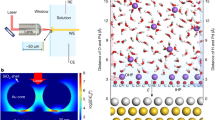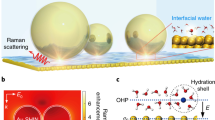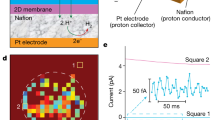Abstract
Aqueous proton transport at interfaces is ubiquitous and crucial for a number of fields, ranging from cellular transport and signalling, to catalysis and membrane science. However, due to their light mass, small size and high chemical reactivity, uncovering the surface transport of single protons at room temperature and in an aqueous environment has so far remained out-of-reach of conventional atomic-scale surface science techniques, such as scanning tunnelling microscopy. Here, we use single-molecule localization microscopy to resolve optically the transport of individual excess protons at the interface of hexagonal boron nitride crystals and aqueous solutions at room temperature. Single excess proton trajectories are revealed by the successive protonation and activation of optically active defects at the surface of the crystal. Our observations demonstrate, at the single-molecule scale, that the solid/water interface provides a preferential pathway for lateral proton transport, with broad implications for molecular charge transport at liquid interfaces.
This is a preview of subscription content, access via your institution
Access options
Access Nature and 54 other Nature Portfolio journals
Get Nature+, our best-value online-access subscription
$29.99 / 30 days
cancel any time
Subscribe to this journal
Receive 12 print issues and online access
$259.00 per year
only $21.58 per issue
Buy this article
- Purchase on Springer Link
- Instant access to full article PDF
Prices may be subject to local taxes which are calculated during checkout




Similar content being viewed by others
Data availability
The data that support the findings of this study are available from the corresponding authors on reasonable request.
References
Kreuer, K. D. Proton conductivity: materials and applications. Chem. Mater. 8, 610–641 (1996).
Chen, M. et al. Hydroxide diffuses slower than hydronium in water because its solvated structure inhibits correlated proton transfer. Nat. Chem. 10, 413–419 (2018).
Reider, G., Höfer, U. & Heinz, T. Surface diffusion of hydrogen on Si (111)7 × 7. Phys. Rev. Lett. 66, 1994–1997 (1991).
Merte, L. R. et al. Water-mediated proton hopping on an iron oxide surface. Science 336, 889–893 (2012).
Kumagai, T. et al. H-atom relay reactions in real space. Nat. Mater. 11, 167–172 (2012).
Tocci, G. & Michaelides, A. Solvent-induced proton hopping at a water-oxide interface. J. Phys. Chem. Lett. 5, 474–480 (2014).
Nagasaka, M., Kondoh, H., Amemiya, K., Ohta, T. & Iwasawa, Y. Proton transfer in a two-dimensional hydrogen-bonding network: water and hydroxyl on a Pt(111) surface. Phys. Rev. Lett. 100, 8–11 (2008).
Grosjean, B., Bocquet, M. L. & Vuilleumier, R. Versatile electrification of two-dimensional nanomaterials in water. Nat. Commun. 10, 1656 (2019).
Bränden, M., Sanden, T., Brzezinkski, P. & Widengren, J. Localized proton microcircuits at the biological membrane–water interface. Proc. Natl Acad. Sci. USA 103, 19766–19770 (2006).
Cherepanov, D. A., Pohl, P., Hagen, V., Antonenko, Y. N. & Springer, A. Protons migrate along interfacial water without significant contributions from jumps between ionizable groups on the membrane surface. Proc. Natl Acad. Sci. USA 108, 14461–14466 (2011).
Serowy, S. et al. Structural proton diffusion along lipid bilayers. Biophys. J. 84, 1031–1037 (2003).
Zhang, C. et al. Water at hydrophobic interfaces delays proton surface-to-bulk transfer and provides a pathway for lateral proton diffusion. Proc. Natl Acad. Sci. USA 109, 9744–9749 (2012).
Karim, W. et al. Catalyst support effects on hydrogen spillover. Nature 541, 68–71 (2017).
Michaelides, A. & Hu, P. Catalytic water formation on platinum: a first-principles study. J. Am. Chem. Soc. 123, 4235–4242 (2001).
Cortright, R. D., Davda, R. R. & Dumesic, J. A. Hydrogen from catalytic reforming of biomass-derived hydrocarbons in liquid water. Nature 418, 964–967 (2002).
Schmidt-Rohr, K. & Chen, Q. Parallel cylindrical water nanochannels in Nafion fuel-cell membranes. Nat. Mater. 7, 75–83 (2008).
Hickner, M. A., Ghassemi, H., Kim, Y. S., Einsla, B. R. & McGrath, J. E. Alternative polymer systems for proton exchange membranes (PEMs). Chem. Rev. 104, 4587–4612 (2004).
Kreuer, K.-D., Paddison, S. J., Spohr, E. & Schuster, M. Transport in proton conductors for fuel-cell applications: simulations, elementary reactions, and phenomenology. Chem. Rev. 104, 4637–4678 (2004).
Ling, X., Bonn, M., Domke, K. F. & Parekh, S. H. Correlated interfacial water transport and proton conductivity in perfluorosulfonic acid membranes. Proc. Natl Acad. Sci. USA 116, 8715–8720 (2019).
Boysen, D. A., Uda, T., Chisholm, C. R. I. & Haile, S. M. High-performance solid acid fuel cells through humidity stabilization. Science 303, 68–70 (2004).
Gopinadhan, K. et al. Complete steric exclusion of ions and proton transport through confined monolayer water. Science 363, 145–148 (2019).
Lee, C. Y., Choi, W., Han, J.-H. & Strano, M. S. Coherence resonance in a single-walled carbon nanotube ion channel. Science 329, 1320–1324 (2010).
Tunuguntla, R. H. et al. Enhanced water permeability and tunable ion selectivity in subnanometer carbon nanotube porins. Science 357, 792–796 (2017).
Zhou, K. G. et al. Electrically controlled water permeation through graphene oxide membranes. Nature 559, 236–240 (2018).
Feng, J. et al. Imaging of optically active defects with nanometer resolution. Nano Lett. 18, 1739–1744 (2018).
Comtet, J. et al. Wide-field spectral super-resolution mapping of optically active defects in hexagonal boron nitride. Nano Lett. 19, 2516–2523 (2019).
Freier, E., Wolf, S. & Gerwert, K. Proton transfer via a transient linear water-molecule chain in a membrane protein. Proc. Natl Acad. Sci. USA 108, 11435–11439 (2011).
Wendt, S. et al. Formation and splitting of paired hydroxyl groups on reduced TiO2. Phys. Rev. Lett. 96, 066107 (2006).
Taniguchi, T. & Watanabe, K. Synthesis of high-purity boron nitride single crystals under high pressure by using Ba-BN solvent. J. Cryst. Growth 303, 525–529 (2007).
Léonard, S., Ingrid, S., Frédéric, F., Annick, L. & Julien, B. Characterization methods dedicated to nanometer-thick hBN layers. 2D Mater. 4, 15028 (2017).
Vogl, T., Campbell, G., Buchler, B. C., Lu, Y. & Lam, P. K. Fabrication and deterministic transfer of high-quality quantum emitters in hexagonal boron nitride. ACS Photonics 5, 2305–2312 (2018).
Martínez, L. J. et al. Efficient single photon emission from a high-purity hexagonal boron nitride crystal. Phys. Rev. B 94, 121405 (2016).
Weston, L., Wickramaratne, D., Mackoit, M., Alkauskas, A. & Van De Walle, C. G. Native point defects and impurities in hexagonal boron nitride. Phys. Rev. B 97, 214104 (2018).
Wang, Q. et al. Photoluminescence upconversion by defects in hexagonal boron nitride. Nano Lett. 18, 6898–6905 (2018).
Agmon, N. Elementary steps in excited-state proton transfer. J. Phys. Chem. A 109, 13–35 (2005).
Scharnagl, C., Raupp-Kossmann, R. & Fischer, S. F. Molecular basis for pH sensitivity and proton transfer in green fluorescent protein: protonation and conformational substates from electrostatic calculations. Biophys. J. 77, 1839–1857 (1999).
Habuchi, S. et al. Photo-induced protonation/deprotonation in the GFP-like fluorescent protein Dronpa: mechanism responsible for the reversible photoswitching. Photochem. Photobiol. Sci. 5, 567–576 (2006).
Janssen, K. P. F. et al. Single molecule methods for the study of catalysis: from enzymes to heterogeneous catalysts. Chem. Soc. Rev. 43, 990–1006 (2014).
Roeffaers, M. B. J. et al. Spatially resolved observation of crystal-face-dependent catalysis by single turnover counting. Nature 439, 572–575 (2006).
Zou, N. et al. Cooperative communication within and between single nanocatalysts. Nat. Chem. 10, 607–614 (2018).
Manley, S. et al. High-density mapping of single-molecule trajectories with photoactivated localization microscopy. Nat. Methods 5, 155–157 (2008).
Bouchaud, J. P., Comtet, A., Georges, A. & Le Doussal, P. Classical diffusion of a particle in a one-dimensional random force field. Ann. Phys. 201, 285–341 (1990).
Zaburdaev, V., Denisov, S. & Klafter, J. Lévy walks. Rev. Mod. Phys. 87, 483–530 (2015).
Heberle, J., Riesle, J., Thiedemann, G., Oesterhelt, D. & Dencher, N. A. Proton migration along the membrane surface and retarded surface to bulk transfer. Nature 370, 379–382 (1994).
Halle, B. & Karlström, G. Prototropic charge migration in water. J. Chem. Soc. Faraday Trans. 79, 1047–1073 (1983).
Sluyters, J. H. & Sluyters-Rehbach, M. The mechanism of the hydrogen ion conduction in liquid light and heavy water derived from the temperature dependence of their limiting conductivities. J. Phys. Chem. B 114, 15582–15589 (2010).
Eilers, Y., Ta, H., Gwosch, K. C., Balzarotti, F. & Hell, S. W. MINFLUX monitors rapid molecular jumps with superior spatiotemporal resolution. Proc. Natl Acad. Sci. USA 115, 6117–6122 (2018).
Reed, D. A. & Ehrlich, G. Surface diffusion, atomic jump rates and thermodynamics. Surf. Sci. 102, 588–609 (1981).
Tran, T. T., Bray, K., Ford, M. J., Toth, M. & Aharonovich, I. Quantum emission from hexagonal boron nitride monolayers. Nat. Nanotechnol. 11, 37–41 (2016).
Weichselbaum, E. et al. Origin of proton affinity to membrane/water interfaces. Sci. Rep. 7, 1–8 (2017).
Kudin, K. N. & Car, R. Why are water-hydrophobic interfaces charged? J. Am. Chem. Soc. 130, 3915–3919 (2008).
Tocci, G., Joly, L. & Michaelides, A. Friction of water on graphene and hexagonal boron nitride from ab initio methods: very different slippage despite very similar interface structures. Nano Lett. 14, 6872–6877 (2014).
Dellago, C. & Hummer, G. Kinetics and mechanism of proton transport across membrane nanopores. Phys. Rev. Lett. 97, 1–4 (2006).
Acknowledgements
J.C. acknowledges valuable discussions with A. Descloux and V. Navikas. This work was financially supported by the Swiss National Science Foundation Consolidator grant (BIONIC BSCGI0_157802) and CCMX project (Large area growth of 2D materials for device integration). E.G. acknowledges support from the Swiss National Science Foundation through the National Centre of Competence in Research Bio-Inspired Materials. The quantum simulation work was performed on the French national supercomputer Occigen under DARI grants A0030807364 and A0030802309. M.-L.B. acknowledges funding from ANR project Neptune. K.W. and T.T. acknowledge support from the Elemental Strategy Initiative conducted by MEXT, Japan, and CREST (JPMJCR15F3), JST.
Author information
Authors and Affiliations
Contributions
J.C. and A.R. conceived and designed the experiments and J.C. performed the experiments with help from E.G. and A.A. J.C. analysed data and wrote the paper, with input from all authors. B.G. carried out simulations, with help from R.V. and M.-L.B, and K.W. and T.T. contributed materials. A.R. supervised the project. All authors discussed the results and commented on the manuscript.
Corresponding authors
Ethics declarations
Competing interests
The authors declare no competing interests.
Additional information
Peer review information Nature Nanotechnology thanks Johan Hofkens, Peter Pohl and the other, anonymous, reviewer(s) for their contribution to the peer review of this work.
Publisher’s note Springer Nature remains neutral with regard to jurisdictional claims in published maps and institutional affiliations.
Supplementary information
Supplementary Information
Supplementary Figs. 1–31, Discussions 1–5 and refs. 1–29.
Supplementary Video 1
Protonation of VB- by H2O. Hydrogen, boron, nitrogen and oxygen atoms are respectively represented in white, blue, green and red while the reactive aqueous species is displayed in cyan.
Supplementary Video 2
Wide-field movie of the flake shown in Fig. 3. Movies are slowed down 5 times (10 frames per second, with 20 ms sampling time). Red circles show positions of localized defects. Circles have 300 nm radius.
Supplementary Video 3
Luminescence trajectory of Fig. 2. Scale bar is 500 nm.
Supplementary Video 4
Luminescence trajectory of Fig. 3a.
Supplementary Video 5
Luminescence trajectory of Fig. 3c.
Supplementary Video 6
Luminescence trajectory of Fig. 3b.
Supplementary Video 7
Luminescence trajectory of Fig. S19A.
Supplementary Video 8
Luminescence trajectory of Fig. S19B.
Supplementary Video 9
Non-biased trajectory of hydronium ion physisorbed at the hBN/water interface. The hydronium, hydrogen, boron, nitrogen and oxygen atoms are respectively represented in yellow, white, blue, green and red.
Rights and permissions
About this article
Cite this article
Comtet, J., Grosjean, B., Glushkov, E. et al. Direct observation of water-mediated single-proton transport between hBN surface defects. Nat. Nanotechnol. 15, 598–604 (2020). https://doi.org/10.1038/s41565-020-0695-4
Received:
Accepted:
Published:
Issue Date:
DOI: https://doi.org/10.1038/s41565-020-0695-4
This article is cited by
-
Enhanced interfacial water dissociation on a hydrated iron porphyrin single-atom catalyst in graphene
Communications Chemistry (2023)
-
Prolonged photostability in hexagonal boron nitride quantum emitters
Communications Materials (2023)
-
Liquid-activated quantum emission from pristine hexagonal boron nitride for nanofluidic sensing
Nature Materials (2023)
-
Ultrahigh resistance of hexagonal boron nitride to mineral scale formation
Nature Communications (2022)
-
Nanofluidics for osmotic energy conversion
Nature Reviews Materials (2021)



